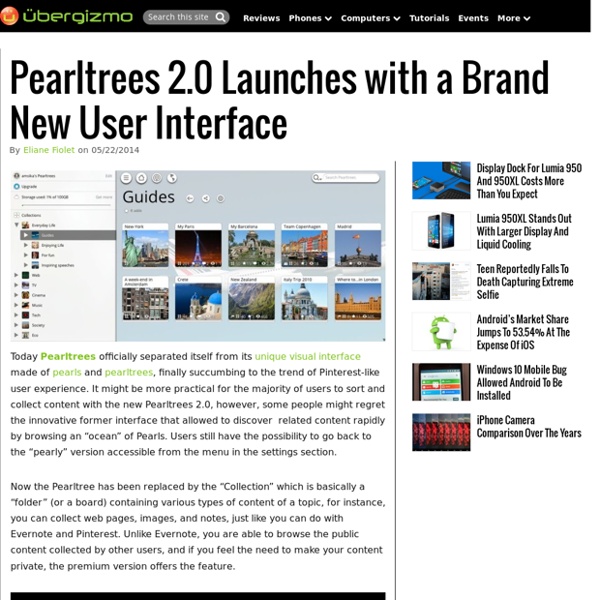Pearltrees releases a new version, without any pearls nor trees
The Paris-based startup founded in 2009 once declared: “We focus on the visual potential of Pearltrees to let people dive deeply into their interests and nearly feel them”. Their product, offering a digital curation tool, was unique because of the visual interface voluntareely original: links and folders symbolized by rounded pearls attached together like the branches of a tree. Today, pearls and trees have disappeared to make room for a brand new and larger organisation tool. Two years ago, everyone wanted to build products around “curation” and “interest graph”. The other main improvement lies in the shift from Flash to HTML5 technology, which will make a huge difference for all those who never update their Flash player – and those who think Flash is “so 2011”. Why giving up the core of the product, after 4,5 years of existence and 1,7 million users? The only drawback is that the design of the app has not changed much and looks a little old to create a real agreeable experience.
Pearltrees: Curation Tool Drops Flash And User Interface For Pintrest-like Format -SVW
Posted by Tom Foremski - May 23, 2014 Pearltrees (a former consulting client) this week introduced the 2.0 version of its popular web page curation tool built completely with HTML 5.0 and with a completely different user interface and metaphor. The tool now represents web pages as a series of rectangles in a "dynamic grid" allowing users to quickly organize and share their web collections. The prior interface was based on circles, or "pearls" connected in a molecular pattern to other "pearls." Sometimes new users thought it looked complicated and the user interface change simplifies people's first impressions. Patrice Lamothe, CEO and co-founder of Pearltrees (above) said the new interface in the latest version makes the tool more powerful and useful because of the drag and drop features, improved sharing, and content discovery technologies. It's quite a risk for any web based service to make such a radical change in its user interface. About Pearltrees
Social Curation Service Pearltrees Revamps Web and Mobile Apps
Pearltrees, the service that allows you to arrange Web content, photos and more (‘pearls’) into mindmap-style ‘trees’, has updated its Web and mobile apps today in order to bring a more seamless user experience and new features to the platform. The company said the Web platform has been fully redesigned and rebuilt in HTML5, making it more easily accessible on a range of different devices, as well as introducing new features also now found in its iOS and Android apps. It seems it’s becoming a bit of a habit for Pearltrees to significantly revamp its website at about this time each year, and this time around it’s gone all-out to make collections, and collecting, “simpler, more accessible and more shareable,” CEO and co-founder Patrice Lamothe said. As well as rebuilding it using HTML 5, there are now new features like ‘extended drag-and-drop’ which allow you to quickly add ‘pearls’ from your hard drive, the Web or a document. ➤ Pearltrees | Google Play | App Store
Pearltrees passe en version 2.0 et change radicalement d'interface
L’outil de curation web basé à Paris Pearltrees vient de passer en version 2.0. Les changements sont assez radicaux pour ce service qui permet à un ou plusieurs utilisateurs en collaboration d’organiser et de partager des collections composées de pages web, d’images, de notes ou encore de fichiers. Jusqu’à présent, l’interface en Flash se présentait sous la forme d’arbres composés de perles. Pour se plier aux standards actuels et probablement pour rendre le fonctionnement du service plus intuitif, Pearltrees 2.0 passe au HTML5 et abandonne les perles qui ont fait son nom au profit de grilles dynamiques. La possibilité de glisser-déposer un élément (document, page web…etc.) dans sa collection depuis son navigateur ou même le Bureau a été ajoutée. Si le passage au HTML5 concerne la version web du service, les applications Android et iOS sont aussi revues.
Pearltrees Radically Redesigns Its Online Curation Service To Reach A Wider Audience
Pearltrees, the Paris-based online curation service that launched in late 2009, was always known for its rather quirky Flash-based interface that allowed you to organize web bookmarks, photos, text snippets and documents into a mindmap-like structure. For users who got that metaphor, it was a very powerful service, but its interface also presented a barrier to entry for new users. Today, the company is launching a radical redesign that does away with most of the old baggage of Pearltrees 1.0. Here is what Pearltrees 1.0 looked like: And here is the new version: Pearltrees’ mission is still to allow you to organize everything you want on the service (in that respect, it almost competes with Evernote). As Pearltrees CEO Patrice Lamothe stressed when I talked to him last week, all of the existing content the company’s over 2 million contributors have added in the past simply transfer over to the new site. 3. The new grid definitely does away with many of the problems of the early version.




not only were you among the first, but it was the best curativng concept currently available to everyone yet you chose to shatter this all with this Pinterest like user experience...their is already a Pinterest, their wasnt anything like pearltrees. we shouldn't succumb to certain trends yet pearltrees surrendered to PInterest resemblance but with much more censorship ofcourse. by aroman May 28
just pointing who said what...;-) by noosquest May 28
Don't succumb to journalist trend yourself :-) This interface has nothing to do with a trend, and if really checked, very different from Pinterest's. We were among the first (probably the first) to define the curation concept and do not intend to stop innovating and start following. by Patrice May 28
from the article : "...finally succumbing to the trend of Pinterest-like user experience...." by noosquest May 28